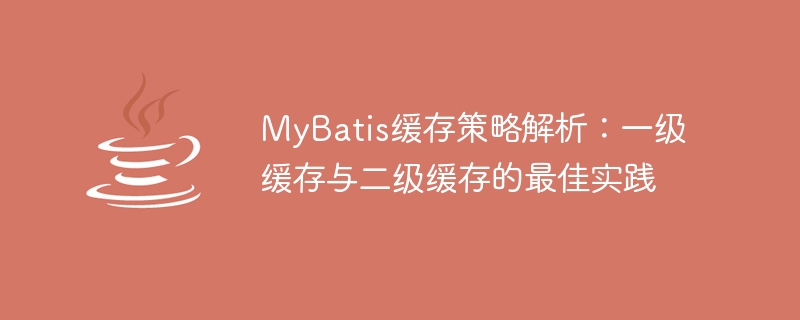

MyBatis cache strategy analysis: best practices for first-level cache and second-level cache
When using MyBatis for development, we often need to consider the choice of cache strategy. The cache in MyBatis is mainly divided into two types: first-level cache and second-level cache. The first-level cache is a SqlSession-level cache, while the second-level cache is a Mapper-level cache. In practical applications, rational use of these two caches is an important means to improve system performance. This article will analyze the best practices of first-level cache and second-level cache in MyBatis through specific code examples.
1. First-level cache
In MyBatis, each SqlSession maintains a local cache, and It's the first level cache. When executing the same query in the same SqlSession, MyBatis will first search from the first-level cache. If the corresponding result is found, it will be returned directly without querying the database.
The life cycle of the first-level cache is the same as the life cycle of SqlSession. That is to say, as long as the SqlSession is not closed, the life cycle of the first-level cache The data will be retained.
The following is a simple example code that demonstrates the use of the first-level cache:
// 获取SqlSession SqlSession sqlSession = sqlSessionFactory.openSession(); // 创建Mapper接口代理对象 UserMapper userMapper = sqlSession.getMapper(UserMapper.class); // 第一次查询 User user1 = userMapper.selectUserById(1); // 第二次查询,因为是同一个SqlSession,会从一级缓存中获取结果 User user2 = userMapper.selectUserById(1); // 关闭SqlSession sqlSession.close();
In the above code, the The first and second queries use the same id. Since the operation is performed in the same SqlSession, the second query will obtain the results directly from the first-level cache.
2. Second-level cache
The second-level cache is a Mapper-level cache. Multiple SqlSession shares the same Mapper. Second level cache of objects. When multiple SqlSession queries the same data of the same Mapper, it will first search from the second-level cache. If found, it will be returned directly without querying the database.
To use the second-level cache, you need to make the corresponding configuration in the MyBatis configuration file:
The following is a simple sample code that demonstrates the use of second-level cache:
// 获取第一个SqlSession SqlSession sqlSession1 = sqlSessionFactory.openSession(); UserMapper userMapper1 = sqlSession1.getMapper(UserMapper.class); User user1 = userMapper1.selectUserById(1); sqlSession1.close(); // 获取第二个SqlSession SqlSession sqlSession2 = sqlSessionFactory.openSession(); UserMapper userMapper2 = sqlSession2.getMapper(UserMapper.class); User user2 = userMapper2.selectUserById(1); sqlSession2.close();
In the above code, the first and second SqlSession queries With the same ID, since the second-level cache is turned on, the second query will directly obtain the results from the second-level cache.
3. Cache Invalidation
Although caching can improve system performance, cache invalidation may occur in some cases. In this case, the cache needs to be cleared in time to ensure data accuracy. Common cache failure situations include: data update, manual cache cleaning, cache expiration, etc.
For the first-level cache, when a cache invalidation occurs, you only need to close the current SqlSession to clear the cache. For the second-level cache, corresponding methods need to be used to clean or update the cache data.
Conclusion
Reasonable use of the first-level cache and the second-level cache can improve system performance, but you need to pay attention to the cache failure and clear the cache in time to avoid data inconsistency. In actual projects, appropriate caching strategies need to be selected based on specific needs to improve system performance and user experience.
The above is about the analysis of MyBatis cache strategy and the best practices of first-level cache and second-level cache. I hope it will be helpful to you.
The above is the detailed content of MyBatis cache strategy analysis: best practices for first-level cache and second-level cache. For more information, please follow other related articles on the PHP Chinese website!
 mybatis first level cache and second level cache
mybatis first level cache and second level cache What is the difference between ibatis and mybatis
What is the difference between ibatis and mybatis How to configure database connection in mybatis
How to configure database connection in mybatis What is the working principle and process of mybatis
What is the working principle and process of mybatis What are the differences between hibernate and mybatis
What are the differences between hibernate and mybatis How to install linux system
How to install linux system How to read excel data in html
How to read excel data in html How to modify the registry
How to modify the registry



